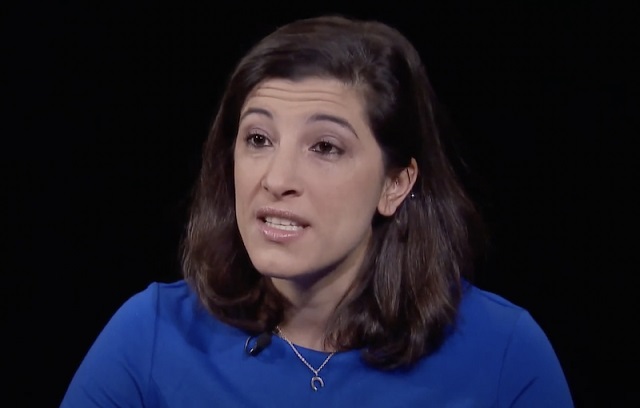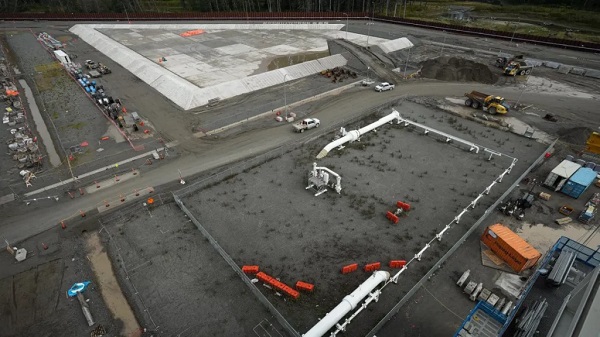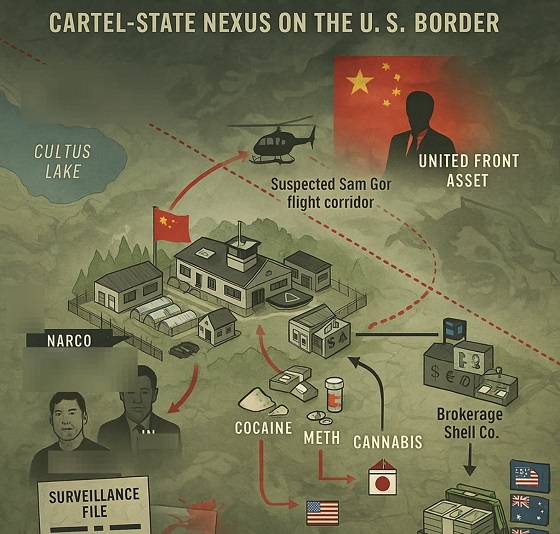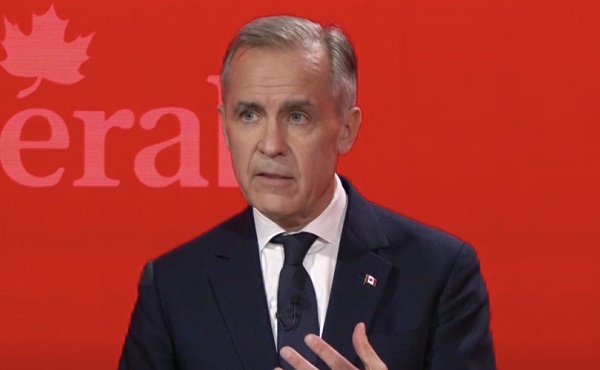Business
How the Deep State is using the ‘Censorship Industrial Complex’ to crush free speech

Renée DiResta is the research director of the Stanford Internet Observatory (SIO)
From LifeSiteNews
The Censorship Industrial Complex, dominated by organizations often run by ex-CIA agents, is working around the First Amendment to suppress dissent and promote a one-world government
Author and reformed climate activist Michael Shellenberger has coined the term “Censorship Industrial Complex,” an apparent reference to President Dwight D. Eisenhower’s Farewell Address in 1961, where the former Army General warned about the influence of the “military-industrial complex.”
In a recently published article, Dr. Joseph Mercola explored the Censorship Industrial Complex, how it works, and who some of the protagonists are. We will examine the following points regarding this nefarious network to understand how the censorship apparatus works:
- A key figure: Renée DiResta
- The Election Integrity Partnership and Virality Project
- The Council on Foreign Relations and the One World Government
- NewsGuard and the “middleware” approach
A key figure: Renée DiResta
Renée DiResta is the research director of the Stanford Internet Observatory (SIO). Mercola fittingly described the organization’s purpose: “[Founded] in June 2019,” the SIO “promote[s] internet censorship policies and conduct[s] real-time social media narrative monitoring.”
DiResta quickly climbed the career ladder despite being involved in a major election manipulation scandal. She previously worked for the CIA and is a member of the influential Council on Foreign Relations (CFR).
DiResta is a prominent example of the connections between the intelligence agency and the censorship industry, but she is certainly not the only one. The organizations that are deciding what is deemed “misinformation” or “hate speech” (i.e., the Censorship Industrial Complex) are often run by former CIA agents. According to Shellenberger’s research, seven former CIA executives serve on the board of the Atlantic Council, an organization partnered with the SIO through several projects.
“The Chief Strategy Officer and the Director of Federal Programs at Graphika, another DiResta partner organization, are former CIA officials,” Shellenberger writes.
In 2018, DiResta organized a false flag online operation that influenced an Alabama Senate race. Before she worked at the SIO, DiResta was the research director at a small political consultant firm, New Knowledge LLC, which received $100,000 from Reid Hoffman, founder of LinkedIn, to help the Democrat candidate win the U.S. Senate race in Alabama. New Knowledge used that money to subscribe thousands of fake Russian bot accounts to Republican candidate Roy Moore’s social media campaign. Mainstream media reports at the time claimed Moore was “backed by Russia,” even though his “Russian backers” were fake accounts created by New Knowledge. Moore’s Democratic opponent, Doug Jones, went on to win the race by a slim margin.
After the election, an internal report from New Knowledge, which detailed the Russian bot operation, was obtained by The New York Times. The report admits that: “We orchestrated an elaborate ‘false flag’ operation that planted the idea that the Moore campaign was amplified on social media by a Russian botnet.”
This revelation gained national media attention and was so scandalous that even members of the Atlantic Council (an organization that now collaborates with DiResta) publicly criticized this egregious example of election interference by New Knowledge.
“Somehow, DiResta survived this scandal and continues to be a leading spokesperson AGAINST disinformation and FOR election integrity, even though New Knowledge was caught red-handed using disinformation to interfere in a U.S. election,” Mercola writes.
Shellenberger said the reason that DiResta was made “the leader of the Censorship Industrial Complex,” next to her intellect and articulateness, is that “[l]ike other American elites, DiResta believes that it is the role of people like her to control what information the public is allowed to consume, lest they elect a populist ogre like Donald Trump, decide not to get vaccinated, or don’t accept whatever happens to be mainstream liberal opinion on everything from climate change to transgenderism to the business dealings of the president[‘s] family.”
The Election Integrity Partnership and Virality Project
The Election Integrity Partnership (EIP) was founded only months before the 2020 U.S. presidential election “to defend our elections against those who seek to undermine them by exploiting weaknesses in the online information environment.”
Mike Benz, former State Department official in the Trump administration and executive director for the Foundation for Freedom Online, explained in a video that EIP was created as a “government cut-out,” a “private” organization that de facto acts as censorship arm for the things the government cannot censor because it lacks the legal authority to do so.
One of the “partners” of the EIP is DiResta’s SIO. Benz also notes that all of the EIP’s partners are at least partly funded by the government.
Elon this video goes over it in insta-PhD level detail. It shows exactly how DHS created the EIP censorship octopus. Condensed to 8 mins here: pic.twitter.com/l5EaxAIChD
— Mike Benz (@MikeBenzCyber) November 7, 2023
In May 2020, a new organization with mostly the same “partners” as the EIP was created, the Virality Project (VP). The VP focused on censoring COVID-related content online, including factual information that “might promote vaccine hesitancy.”
A spokesperson from the SIO (one of the VP’s founding partners) claimed it “did not censor or ask social media platforms to remove any social media content regarding coronavirus vaccine side effects.” Perhaps the SIO did not censor content directly, but the VP that was founded by the SIO certainly did, as the Twitter Files released by Elon Musk have shown.
According to the Twitter Files published by journalist Matt Taibbi, the VP pressured social media platforms such as Twitter (now X) and TikTok to remove or flag online content. Posts flagged by VP included:
- True information that could fuel “vaccine hesitancy”
- Posts critical of vaccine passports
- True testimonies of people experiencing blood clots after receiving COVID shots
- People asking questions about possible adverse reactions from the jabs
The Council on Foreign Relations and the One World government
As mentioned above, DiResta, in addition to being a former CIA agent, is also a member of the Council on Foreign Relations (CFR), a think tank specialized in U.S. foreign policy. The globalist CFR is partly funded by the Bill & Melinda Gates Foundation and the Rockefeller Foundation.
The CFR was founded in 1921 and has heavily influenced U.S. foreign policy ever since. Most CIA directors and U.S. secretaries of defense have been members of the Council. Mercola argues that the CFR’s ultimate goal “has been to bring about a totalitarian one world government, a New World Order (NWO) with global top-down rule.”
According to the Centre for Research on Globalization, James Warburg, the son of one of the CFR’s founders, told the Senate Foreign Relations Committee in 1950: “We shall have world government whether or not you like it – by conquest or consent.”
Moreover, CFR insider and former U.S. Navy Admiral Chester Ward stated the following in his 1975 book Kissinger on the Couch:
“[The CFR has as a goal] submergence of U.S. sovereignty and national independence into an all-powerful one-world government … This lust to surrender the sovereignty and independence of the United States is pervasive throughout most of its membership … In the entire CFR lexicon, there is no term of revulsion carrying a meaning so deep as ‘America First.’”
Mercola concludes that the Censorship Industrial Complex is part of the network that seeks to establish a one-world government.
“Those who oppose America First policies do so because they’re working on behalf of a network that seeks to eliminate nationalism in favor of a one-world government, and DiResta is part of that club,” he writes.
NewsGuard and the ‘middleware approach’
In another condensed video, Benz explains how the Censorship Industrial Complex is now using so-called “middleware” organizations like the news rating site NewsGuard to suppress dissent from the mainstream narratives.
The "Middleware" Plan To Restructure The Censorship Industry
1. Middleware = 'censorship as a service' orgs
2. Morphing from top-down to middle-out
3. Regs + middleware = disinfo compliance market pic.twitter.com/lDPqH72HrD
— Mike Benz (@MikeBenzCyber) August 1, 2023
According to Benz, the Censorship Industrial Complex is anticipating a loss in the Missouri v. Biden Supreme Court case, which “threatens to ban all government coordination of domestic censorship with a few exceptions[.]”
To circumvent these possible legal restrictions, the government is propping up “intermediary censorship mercenary firms like NewsGuard.”
READ: Elon Musk slams leftist rating group NewsGuard as ‘scam’ that ‘should be disbanded immediately’
By funding these “private” organizations, the deep state government agencies can “effectively circumvent the First Amendment prohibitions on running a comparable thing out of the DHS [Department of Homeland Security].”
However, the idea that NewsGuard is somehow independent from the government is wholly divorced from reality. In 2021, the Department of Defense awarded NewsGuard $750,000 for its project “Misinformation Fingerprints,” which aims to combat what it calls “a catalogue of known hoaxes, falsehoods and misinformation narratives that are spreading online.”
Moreover, Benz notes that NewsGuard’s Advisory Board consists of “an all-star apex predator caste of the national security state,” including
- retired Four-Star General Michael Hayden, who was formerly the head of the CIA and NSA,
- Richard Stengel, former Undersecretary of State,
- Tom Ridge, former head of the DHS,
- and Anders Fogh Rasmussen, former head of NATO.
By propping up “middleware” companies such as NewsGuard that are not technically part of the government, the Censorship Industrial Complex is able to work around possible First Amendment restrictions, as websites that receive a negative rating from NewsGuard will have reduced visibility on Big tech platforms and search engines. The negative rating by NewsGuard also provides a pretext for private Big Tech platforms to label outlets as spreaders of “misinformation” and censor them outright.
“There’s no clear solution to this threat, other than to continue pushing back against any and all efforts to legalize, standardize and normalize censorship,” Mercola writes in his conclusion. “To vocally object, to refuse using middleware like NewsGuard, and to boycott any company or organization that uses middleware or engages in censorship of any kind.”
Business
U.S., China agree to 90-day tariff reduction after negotiations

 MxM News
MxM News
Quick Hit:
The United States and China have agreed to reduce tariffs for 90 days following trade negotiations in Geneva, offering temporary relief to global markets. The deal marks a pause in the escalating economic conflict, with both countries pledging to resume talks during the truce.
Key Details:
- The U.S. will lower tariffs on Chinese imports from April levels by 24 percentage points, maintaining a 10% base rate.
- China will implement a matching reduction and suspend additional non-tariff measures targeting American goods.
- S&P 500 futures jumped 3%, while U.S. bond yields climbed as investors reacted to signs of de-escalation.
🚨 Treasury Secretary @SecScottBessent announces a major trade deal with China:
“We have reached an agreement on a 90-day pause and substantially move down the tariff levels. Both sides on the reciprocal tariffs will move their tariffs down 115%.” pic.twitter.com/d89RFR3jA4
— Trump War Room (@TrumpWarRoom) May 12, 2025
Diving Deeper:
After weeks of mounting economic tension, the United States and China on Monday jointly announced a 90-day reduction in tariffs, signaling a temporary easing of the trade war that has unnerved businesses, investors, and policymakers across the globe.
The agreement, reached during weekend negotiations in Geneva, was confirmed by U.S. Treasury Secretary Scott Bessent. “We had very robust discussions. Both sides showed great respect to what was a very positive process,” Bessent said in remarks to reporters. According to Bessent, the U.S. will lower its tariffs to 30%, while China will cut its rates to 10% during this period—a proportional rollback from their respective April highs.
The White House clarified that the reduction affects tariffs announced by President Trump on April 2, cutting them by 24 percentage points while keeping the base ad valorem rate of 10%. In response, Beijing agreed not only to match the tariff rollback but also to lift administrative barriers and non-tariff measures it had imposed since April.
Both countries are expected to implement the agreed measures by Wednesday. The joint statement released following the talks indicated that discussions will continue over the coming months as the two sides explore a longer-term resolution.
Markets reacted quickly and positively. S&P 500 futures surged over 3% on the news, providing a shot of optimism after weeks of uncertainty. The U.S. Dollar Index, which had been under pressure due to investor anxiety about America’s trade posture, rose more than 1%. Meanwhile, bond markets adjusted sharply, with the yield on the 10-year Treasury climbing to 4.445%, its highest point since early April.
While the 90-day pause offers breathing room, the underlying issues remain unresolved. Businesses that had delayed orders due to tariff costs may now rush to restock, a move that could cause short-term volatility or even a demand shock in some sectors. Economists warn that without a longer-term agreement, the reprieve may prove fleeting.
For now, though, the breakthrough offers a glimmer of hope. It’s a notable win for President Trump’s strategy of tough negotiations, underscoring his administration’s commitment to putting American interests first while forcing adversaries to the table. The outcome stands in stark contrast to the previous administration’s conciliatory tone and may reinforce the argument for a more assertive U.S. economic posture on the world stage.
Business
Welcome to Elon Musk’s New Company Town: ‘Starbase, TX’ Votes To Incorporate


From the Daily Caller News Foundation
By
Voters in Cameron County, Texas, overwhelmingly approved Saturday a measure to incorporate Elon Musk’s rocket complex near Brownsville as a new municipality called Starbase.
Unofficial results posted Saturday night showed 98% of the 177 ballots cast supported the creation of the town, which includes SpaceX facilities and housing tied to the company, according to The Wall Street Journal. Only residents living within the proposed town’s boundaries were eligible to vote, most of whom work for or are affiliated with SpaceX.
Once county commissioners certify the election, Starbase will begin operating as an official municipality under Texas law, which marks the launch of a rare company-run town where most residents are tied to SpaceX. The new town will oversee zoning, budgeting, and staffing while adhering to state transparency rules such as open meetings and public records requirements.
SpaceX has said little publicly about its plans, but company officials previously suggested the town could help streamline operations and support workforce growth. SpaceX vice president Bobby Peden was elected mayor of the new town and legal experts noted that state law includes conflict-of-interest rules for public officials employed by private firms operating within the municipality.
Local officials have expressed support for the company due to the thousands of jobs and tourism revenue generated by Starbase since SpaceX employs roughly 3,400 workers and contractors at Starbase. However, some residents and environmental groups remain concerned about increased rocket activity, limited beach access, and the town’s close ties to the company that created it.
The Starbase site has become central to Musk’s vision of human spaceflight, particularly SpaceX’s development of Starship, a nearly 400-foot rocket designed for missions to the moon and Mars. Though early test flights have ended in explosions, recent missions have demonstrated partial recovery capabilities and Musk described the area as a “Gateway to Mars.”
Musk will not hold a formal political role in Starbase, but the town is his brainchild, and since announcing the idea in 2021, he has urged employees to move there and expanded his personal and corporate presence in Texas. He relocated his primary residence and key businesses to the state and now lives in a $35 million compound in Austin.
-

 Alberta1 day ago
Alberta1 day agoPremier Smith seeks Alberta Accord: Announces new relationship with Ottawa
-

 Energy23 hours ago
Energy23 hours agoIt’s time to get excited about the great Canadian LNG opportunity
-

 Crime22 hours ago
Crime22 hours agoInside B.C.’s Cultus Lake Narco Corridor — How Chinese State-Linked Syndicates are Building a Narco Empire in Canada
-

 International18 hours ago
International18 hours agoIce Surprises – Arctic and Antarctic Ice Sheets Are Stabilizing and Growing
-

 Energy1 day ago
Energy1 day agoIs the Carney Government Prepared to Negotiate a Fair Deal for the Oil, Gas and Pipeline Sectors
-

 Alberta20 hours ago
Alberta20 hours agoEnergy projects occupy less than three per cent of Alberta’s oil sands region, report says
-

 Health1 day ago
Health1 day agoJay Bhattacharya Closes NIH’s Last Beagle Lab
-

 Business1 day ago
Business1 day agoWelcome to Elon Musk’s New Company Town: ‘Starbase, TX’ Votes To Incorporate

